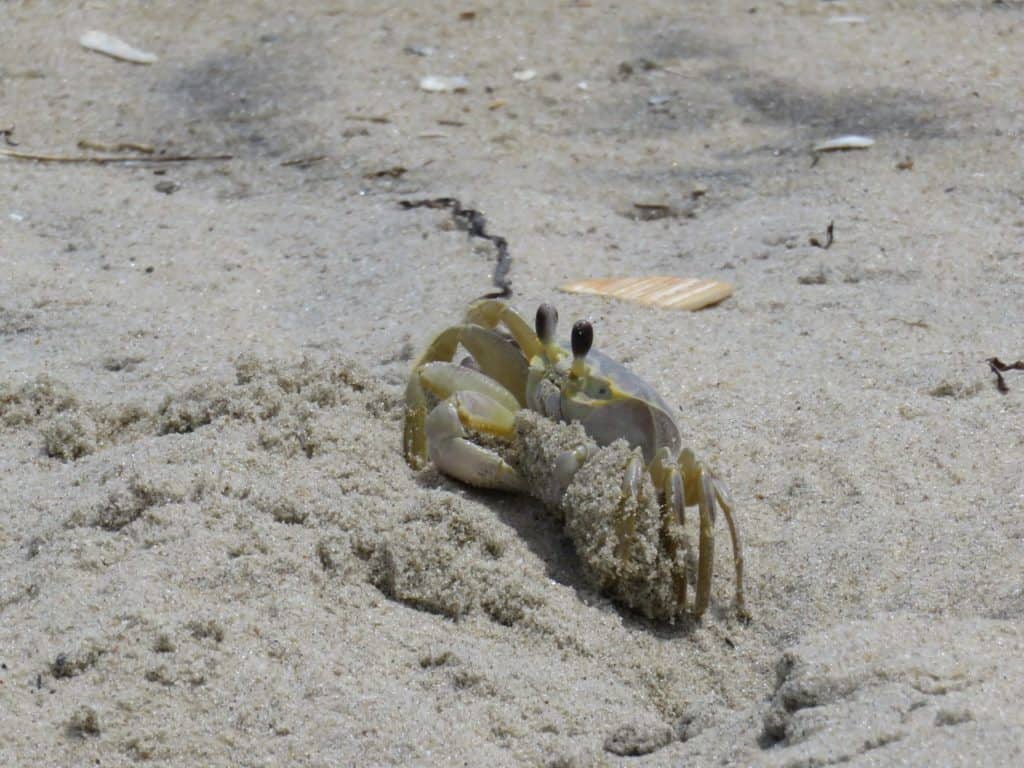Creature Feature

Ghosts among the Dunes
By Bradley Stevens
Editor’s Note: Filling in for Wayne Bierbaum’s Creature Feature this week is Bradley Stevens, author and retired professor of marine science from the University of Maryland Eastern Shore.
Walking along a beach last summer in the remote Virginia barrier islands, I came across a jumble of disturbed sand pockmarked with holes and little scratch marks. My first thought was that a dog had been digging in the sand, but there were no dogs on that beach—nor any other people for that matter. I then realized I was looking at a ghost town—literally, a village of ghost crab burrows and footprints.
I sat down nearby and waited quietly. Scritch scritch scritch. Pffft.
The sound drew my attention. I turned my head to the left, then right. Nothing.
Scritch scritch. Pfft. There’s movement in my peripheral vision. I turn towards the sound.
Pfft, a small cloud of sand erupts from the beach. Remaining as still as possible, I watch a small pile of sand a few feet away from me.
Pfft, another small eruption from a hole behind the sand pile. There, a pair of dark eyes on stalks is looking back at me. We stare at each other for almost a minute. The eyes, attached to a ghost crab, disappear back down the hole. I wait for it to reappear, but it doesn’t. Aware of my existence now, the crab has decided to remain out of sight.
Ghost crabs are small, 2- to 3-inch wide occupants of many coastal beaches around the world. Their burrows are a round hole next to a small mound of sand, usually surrounded by tracks made during foraging trips. The species common on DelMarVa beaches is known to scientists as Ocypode quadrata (o-SIP-a-dee kwa-drata), meaning “swift-footed square-shell”, and is abundant from Rhode Island to Brazil. The common name ghost crab refers to their pale white or sandy color and habit of running across the beach at night.
As I watch, crabs come out of their burrows and sweep a handful (claw-full?) of sand up onto the growing pile of discarded diggings, then scurry back into their hideaways. Occasionally one carries its detrital bolus football style, tucked up against its shell, for several feet before flinging it away and running back to safety. They are cleaning house, preparing their burrows for double occupancy, while waiting for a suitable mate to arrive.
Ghost crab burrows can be 3- to 4-feet deep and may be straight, or shaped like a V, L, or W. The crabs tend to stay in their burrows during the day, during which they may close the entrance to trap moisture. After dark, they come out to feed, then dig a new burrow at sunrise, rarely returning to the same burrow. Although they can stay out of water for extended periods of time, they occasionally need to refresh the water in their gills by taking a dip in the surf (but not too long, or they’ll drown). They can also extract some moisture from the sand in their burrows.
Ghost crabs have one claw larger than the other and can be either left- or right-handed, unlike hermit crabs that are almost always right-handed (to conform with the snail shells they live in). The proportion of each can vary among beaches. Ghost crabs defend their burrows by ritualized “fighting” with their claws, but tend to primarily fight like-handed crabs, whereas opposite-handed crabs are at a disadvantage and tend to evade fights altogether, usually by being active at different times of dawn and dusk.
Crabs don’t hear well, but they can communicate. In a process called stridulation, the crab scrapes its claw across the base of the leg, causing it to vibrate. Motion sensors on the fourth leg detect these and other low frequency vibrations.
During mating season, crabs wander the beach and enter burrows looking for mates. The crabs in the burrows may defend them by stridulating or repeatedly beating the burrow walls with their claws.
Ghost crabs are the largest invertebrates on most beaches, and thus an apex predator, feeding on mole crabs and small bivalves. They occasionally dine on sea turtle eggs, but their impact is minor, so efforts to eliminate them from turtle nesting areas are misguided. Their major predators are birds, especially gulls, but they are also prey for raccoons and burrowing owls.
Many people enjoy “hunting” for ghost crabs on the beaches at night with flashlights. If spotted, the crab will freeze briefly like a deer in headlights. But be respectful and try not to damage the crabs or their burrows. While not dangerous, they can give you a nasty pinch if cornered. The best time to see them is during breeding season, from April to July, whereas ghost crabs tend to hibernate in their burrows from October to April.
On Assateague and Chincoteague beaches, tourists, beachgoers, and fishermen often overlook ghost crabs. But they are still important ecological components of the beaches and need to be conserved. Reducing off-road vehicle traffic on beaches, especially at night, would help maintain crab populations and the diversity of the beach ecosystem. Healthy beaches provide more support for fish and bird populations and are more enjoyable for human recreation as well. And isn’t that why we go there?
As for myself, I look forward to spending future sunny days watching the antics of my crusty little friends, and hoping their beaches remain crab-friendly for many years to come.
